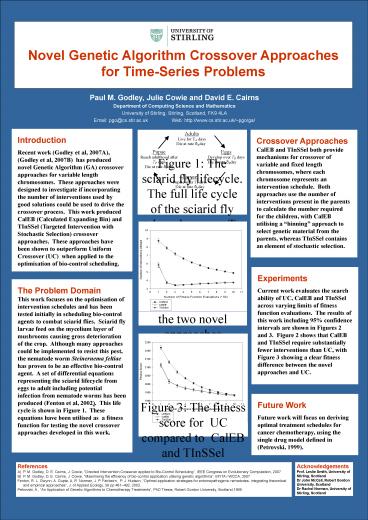The Problem Domain - PowerPoint PPT Presentation
1 / 1
Title:
The Problem Domain
Description:
... to resist this pest, the nematode worm Steinernema feltiae has proven to ... including potential infection from nematode worms has been produced (Fenton et ... – PowerPoint PPT presentation
Number of Views:132
Avg rating:3.0/5.0
Title: The Problem Domain
1
Novel Genetic Algorithm Crossover Approaches for
Time-Series Problems
Paul M. Godley, Julie Cowie and David E.
Cairns Department of Computing Science and
Mathematics University of Stirling, Stirling,
Scotland, FK9 4LA Email pgo_at_cs.stir.ac.uk Web
http//www.cs.stir.ac.uk/pgo/ga/
Introduction Recent work (Godley et al, 2007A),
(Godley et al, 2007B) has produced novel Genetic
Algorithm (GA) crossover approaches for variable
length chromosomes. These approaches were
designed to investigate if incorporating the
number of interventions used by good solutions
could be used to drive the crossover process.
This work produced CalEB (Calculated Expanding
Bin) and TInSSel (Targeted Intervention with
Stochastic Selection) crossover approaches.
These approaches have been shown to outperform
Uniform Crossover (UC) when applied to the
optimisation of bio-control scheduling.
Crossover Approaches CalEB and TInSSel both
provide mechanisms for crossover of variable and
fixed length chromosomes, where each chromosome
represents an intervention schedule. Both
approaches use the number of interventions
present in the parents to calculate the number
required for the children, with CalEB utilising a
binning approach to select genetic material
from the parents, whereas TInSSel contains an
element of stochastic selection.
Figure 1 The sciarid fly lifecycle. The full
life cycle of the sciarid fly takes place over TE
TL TP TA days
Experiments Current work evaluates the search
ability of UC, CalEB and TInSSel across varying
limits of fitness function evaluations. The
results of this work including 95 confidence
intervals are shown in Figures 2 and 3. Figure 2
shows that CalEB and TInSSel require
substantially fewer interventions than UC, with
Figure 3 showing a clear fitness difference
between the novel approaches and UC.
The Problem Domain This work focuses on the
optimisation of intervention schedules and has
been tested initially in scheduling bio-control
agents to combat sciarid flies. Sciarid fly
larvae feed on the mycelium layer of mushrooms
causing gross deterioration of the crop.
Although many approaches could be implemented to
resist this pest, the nematode worm Steinernema
feltiae has proven to be an effective bio-control
agent. A set of differential equations
representing the sciarid lifecycle from eggs to
adult including potential infection from nematode
worms has been produced (Fenton et al, 2002).
This life cycle is shown in Figure 1. These
equations have been utilised as a fitness
function for testing the novel crossover
approaches developed in this work.
Figure 2 The intervention usage for UC compared
to the two novel approaches developed in this work
Future Work Future work will focus on deriving
optimal treatment schedules for cancer
chemotherapy, using the single drug model defined
in (Petrovski, 1999).
Figure 3 The fitness score for UC compared to
CalEB and TInSSel
- References
- A) P. M. Godley, D. E. Cairns, J. Cowie,
Directed Intervention Crossover applied to
Bio-Control Scheduling, IEEE Congress on
Evolutionary Computation, 2007 - B) P. M. Godley, D. E. Cairns, J. Cowie,
Maximising the efficiency of bio-control
application utilising genetic algorithms, EFITA
/ WCCA, 2007 - Fenton, R. L. Gwynn, A. Gupta, A, R. Norman, J.
P. Fairbairn, P. J. Hudson, Optimal application
strategies for entomopathogenic nematodes
integrating theoretical and empirical
approaches, J. of Applied Ecology, 39 pp
481492, 2002. - Petrovski, A., An Application of Genetic
Algorithms to Chemotherapy Treatments, PhD
Thesis, Robert Gordon University, Scotland,1999
Acknowledgements Prof. Leslie Smith, University
of Stirling, Scotland Dr John McCall, Robert
Gordon University, Scotland Dr Rachel Norman,
University of Stirling, Scotland































